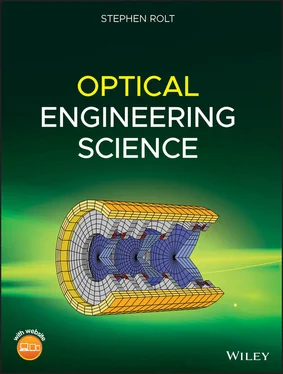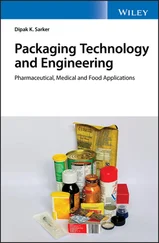13 Chapter 19Table 19.1 Relative mirror distortion for different mounting strategies.Table 19.2 Allowable stresses for some optical materials.Table 19.3 Thermal expansion for some useful materials.
14 Chapter 20Table 20.1 ISO 10110 summary.Table 20.2 Index inhomogeneity classification.
15 Chapter 21Table 21.1 Summary of adhesive properties and applications.Table 21.2 Cleanroom particulate standards.Table 21.3 Days of cleanroom exposure required to produce cleanliness level L = ...
1 Chapter 1 Figure 1.1 The electromagnetic spectrum. Figure 1.2 Relationship between rays and wavefronts. Figure 1.3 Arbitrary ray path between two points. Figure 1.4 Constraint of rays with respect to optical axis. Figure 1.5 Generalised optical system and conjugate points. Figure 1.6 Location of first focal point. Figure 1.7 Principal points and principal planes. Figure 1.8 System focal lengths. Figure 1.9 Tracing of arbitrary ray. Figure 1.10 Angular magnification and nodal points. Figure 1.11 Generalised object and image. Figure 1.12 Refraction at a plane surface. Figure 1.13 Refraction at a spherical surface. Figure 1.14 Refraction by two spherical surfaces (lens). Figure 1.15 Reflection at a plane surface. Figure 1.16 Reflection from a curved surface. Figure 1.17 Complex optical system. Figure 1.18 Modelling of complex systems. Figure 1.19 Thick lens. Figure 1.20 Hubble space telescope schematic.
2 Chapter 2 Figure 2.1 Aperture stop. Figure 2.2 Location of entrance and exit pupils. Figure 2.3 Cooke triplet. Figure 2.4 Optical system with a telecentric output. Figure 2.5 Vignetting. Figure 2.6 (a) Tangential ray fan; (b) Sagittal ray fan. Figure 2.7 Simple magnifying lens. Figure 2.8 Compound microscope. Figure 2.9 Basic optical telescope. Figure 2.10 Basic camera.
3 Chapter 3 Figure 3.1 (a) Gaussian imaging. (b) Impact of aberration. Figure 3.2 Transverse and longitudinal aberration. Figure 3.3 (a) Ray fan for pure third order aberration. (b) Ray fan with third... Figure 3.4 Balancing defocus against aberration – optimal focal position. Figure 3.5 Illustration of optical path difference. Figure 3.6 Wavefront representation of aberration. Figure 3.7 Simplified wavefront and ray geometry. Figure 3.8 Quartic OPD fan. Figure 3.9 OPD fan with balancing defocus. Figure 3.10 (a) Generic layout. (b) Layout with y co-ordinate transformation.... Figure 3.11 Geometrical spot associated with spherical aberration. Figure 3.12 OPD fan for coma. Figure 3.13 Ray fan for coma. Figure 3.14 Geometrical spot for coma. Figure 3.15 Field curvature. Figure 3.16 Ray fan plots illustrating field curvature. Figure 3.17 Ray fan for astigmatism showing tangential and sagittal fans. Figure 3.18 Geometric spot vs. defocus for astigmatism. Figure 3.19 (a) Pincushion (positive) distortion. (b) Barrel (negative) distor...
4 Chapter 4 Figure 4.1 Calculation of OPD for refractive surface. Figure 4.2 Aplanatic points for refraction at single spherical surface. Figure 4.3 Hyperhemisphere objective. Figure 4.4 Field curvature for single refraction. Figure 4.5 Reflection at spherical mirror. Figure 4.6 Petzval curvature for mirror. Figure 4.7 Spherical aberration in cover slip. Figure 4.8 Aberration analysis for thin lens. Figure 4.9 Conjugate parameter. Figure 4.10 Coddington lens shape parameter. Figure 4.11 Spherical aberration vs. shape parameter for a thin lens. Figure 4.12 Coma vs lens shape for various conjugate parameters. Figure 4.13 Spherical aberration vs shape factor for various conjugate paramet... Figure 4.14 Aplanatic meniscus lens. Figure 4.15 Impact of stop movement. Figure 4.16 Simple symmetric lens system with stop shift. Figure 4.17 Impact of stop shift for simple symmetric lens system. Figure 4.18 Abbe sine condition. Figure 4.19 Fulfilment of Abbe sine condition for aplanatic meniscus lens. Figure 4.20 Refractive index variation with wavelength for SCHOTT BK7 glass ma... Figure 4.21 Longitudinal chromatic aberration. Figure 4.22 Transverse chromatic aberration. Figure 4.23 Huygens eyepiece. Figure 4.24 Abbe diagram. Figure 4.25 The achromatic doublet. Figure 4.26 Secondary colour. Figure 4.27 Plot of partial dispersion against Abbe number. Figure 4.28 Contribution of different aberrations vs. numerical aperture for 2...
5 Chapter 5 Figure 5.1 Ellipsoid of revolution. Figure 5.2 Single refractive surface at infinite conjugate. Figure 5.3 Simple two lens system employing aspheric components. Figure 5.4 Polar pupil coordinates. Figure 5.5 Fifth order Zernike polynomial and aberration balancing.
6 Chapter 6 Figure 6.1 Conceptual illustration of Huygens' principle. Figure 6.2 Huygens secondary wave geometry. Figure 6.3 Geometry for Rayleigh diffraction equation of the first kind. Figure 6.4 Far field diffraction. Figure 6.5 Far field diffraction of laser beam emerging from fibre. Figure 6.6 Imaging of a Fraunhofer diffraction pattern by a simple lens. Figure 6.7 Diffraction of evenly illuminated pupil. Figure 6.8 Airy disc. Figure 6.9 Graphical trace of Airy disc. Figure 6.10 The Rayleigh criterion and ideal diffraction limited resolution. Figure 6.11 Profile of two point sources just resolved under Rayleigh criterio... Figure 6.12 Gaussian beam. Figure 6.13 Form of expanding Gaussian beam and beam waist. Figure 6.14 A selection of low order Hermite polynomials.Figure 6.15 Fresnel integral and Cornu spiral.Figure 6.16 Fresnel diffraction at 100 mm from 2 mm Slit – λ = 500 nm.Figure 6.17 Geometric spots for spherical aberration and coma.Figure 6.18 OPD map across pupil.Figure 6.19 Huygens point spread function.Figure 6.20 MTF pattern.Figure 6.21 Typical MTF plot.Figure 6.22 1951 USAF resolution test chart.
7 Chapter 7Figure 7.1 Emission from a generic source.Figure 7.2 Operation of the inverse square law.Figure 7.3 Radiance and exitance from a surface.Figure 7.4 Xenon arc lamp spectral intensity.Figure 7.5 Solar spectral irradiance.Figure 7.6 Solar spectral radiance and 5800 K blackbody radiance.Figure 7.7 Étendue of a pencil of rays.Figure 7.8 Illustration of BRDF.Figure 7.9 BRDF of Spectralon at 900 nm for normal illumination.Figure 7.10 Surface roughness.Figure 7.11 PSD for idealised polished surface (note units are in microns).Figure 7.12 Köhler illumination.Figure 7.13 Diffuser scattering profile.Figure 7.14 Integrating sphere.Figure 7.15 (a) Flux measurement. (b) Reflectance measurement.Figure 7.16 Natural vignetting.Figure 7.17 Substitution radiometer.Figure 7.18 Blackbody radiometric source.Figure 7.19 FEL lamp calibration.Figure 7.20 Luminous efficiency function.Figure 7.21 Luminous efficiency vs. blackbody temperature.Figure 7.22 Luminance vs. blackbody temperature.Figure 7.23 Colour matching curves.Figure 7.24 Standard astronomical filter response curves.
8 Chapter 8Figure 8.1 Plane polarised waves.Figure 8.2 Polarisation states (a) Linear, (b) Right hand circular, (c) Left h...Figure 8.3 Polarisation ellipse.Figure 8.4 Reflection at an interface.Figure 8.5 Reflection coefficient vs angle for n = 1.5.Figure 8.6 Induced dipole formation in refractive material.Figure 8.7 Index ellipsoid.Figure 8.8 Phase delay and propagation through a birefringent crystal.Figure 8.9 Propagation of light in a uniaxial crystal.Figure 8.10 Double refraction in calcite.Figure 8.11 Phenomenon of walk-off in birefringent crystals.Figure 8.12 Operation of half-waveplate.Figure 8.13 Common experimental configuration for quarter waveplate.Figure 8.14 Woolaston prism.Figure 8.15 Glan taylor polariser.Figure 8.16 Polarising beamsplitter cube.Figure 8.17 Wire grid polariser.Figure 8.18 (a) Optical isolator in transmission. (b) Blocking by optical isol...Figure 8.19 Application of jones matrices.Figure 8.20 Jones matrix multiplication.Figure 8.21 Twisted nematic liquid crystal.Figure 8.22 Use of stress induced birefringence to analyse patterns of stress....
9 Chapter 9Figure 9.1 Resonant dipole.Figure 9.2 Modelled index of SCHOTT BK7 ®.Figure 9.3 Thermal sensitivity and effect of substrate.Figure 9.4 Refractive index of air.Figure 9.5 Complex index of aluminium.Figure 9.6 Reflectivity of principal metal coatings.Figure 9.7 Reflection coefficient vs angle for aluminium at 800 nm.Figure 9.8 Band gap in semiconductors.Figure 9.9 Glass transmission vs wavelength (internal transmission for 10 mm t...Figure 9.10 Internal transmission for crystalline halides (10 mm thickness).Figure 9.11 Internal transmission for some chalcogenides (10 mm thickness).Figure 9.12 Internal transmission for some semiconductors (10 mm thickness).
Читать дальше











